Content
(a click to the sub-title leads to the article section)
- Frame
Conditions
- Energy
Requirements
- Mission and
Goals of the Energy Concept
- Actions and
Solutions
-
- Capital
Expenditure
- Block
Diagram
1. Frame Conditions
- Open alpine association hut of category I, new building, low
energy house, special wooden construction
- 31 beds; 60 mattresses; 90 seats for dining in 2
rooms
- about 4000 accomodation-guests per year; 10.000
day-visistors
- open from may until november, through new years eve, and on
easter (sum about 204 days)
- material transport on a forrest-road (11km), further via
ropeway (max. 150kg netto, abt. 250m height)
- way-connections to Bad Tölz, Benediktbeuern, Jachenau,
Lenggries, Kochel, Walchensee
- from the end of the forrest-road access to the hut only by feed
on a winding path
2. Energy Requirements
Based on the operation of the old hut we have known the
experienced data of the "direct" energy consumers, f.i. ropeway
operation, water pump, lighting system, cooking and washing.
heating was mostly in the area of the hutkeeper with the woodstove
of the kitchen (it was also used to produce a little amount of hot
water for the kitchen and personnel). The two tiled stoves in the
dayroom (the only heating sources of the old hut) had been used not
often and not sufficiently. For cooking also liquid gas was
used.
The "indirect" energy consumption of the hut in the environment had
been about 1700 liters of fuel ( f.i. for the daily one, mostly two
transports of personnel from Benediktbeuern to the base station of
the ropeway, the daily supply rides of the hutkeeper for fresh
food, the weekly supply rides for the delivery of drinks - cooled
and in bottles).
Hypothesis: 23 km forrest road and 500m height per ride.
The direct and indirect energy requirement of the old hut were used
as a base for the planning of a new ecological overall concept of
the new hut and also for a new energy concept.
The daily energy requirements has been 40 kWh electrically and 90
kWh thermically.
3. Mission and Goals of the Energy Concept
- Arguments of an optimum economy and minimum capital expenditure
must not get highest priority although economy and ecology should
be estimated equal.
- Highest possible reduction of the overall emissions from the
operation of the hut during summer and winter, ( supply rides,
personnel rides, noise, exhaust fumes, waste water)
- Exact regard of a lawfulness Operation of the hut
- Full comfort of the hut and a sufficient offer of accomodation,
food and drinks by intelligent solutions
- Temporary heating through the opening period when temerature is
low, weather is bad, at night and when from september on the hut
lies in the shadow of the northern wall
- Sufficient cooling of the depots of fresh food (safe against
vermin) and sale of drinks primarily based on big containers
- Block-heating-generator, capable of automated starting, with
ecologically beneficial fuel, independant of personnel
- 100% exploitation of the motor-heat for the thermal energy
requirement of the hut; no emergency cooling at normal
operation
- Low budget operation, also during the hut-closing at
wintertime
- Low service requirements by robust, simple individual devices
of the energy supply
- Safe possibilities for replacement of individual devices at the
end of lifetime
- Reliable redundancy of the devices
4. Actions and Solutions
During longlasting model-calculations specialists have together
experienced the theoretically best way of solutions. Because of the
additionally necessary requirements the overall energy requirements
rarely can be reduced, but will be shifted more to the direct
energy requirements. The produced energy will be optimally used
with the latest state of the art.
The usable power for
the hut has been doubled to times before. The pollution could be
reduced to 30 percent compared to the installations before (in
spite of increasing the power!).
Destruction of environment by transports of dangerous goods will
be avoided.
The success of the new energy concept will be fully reached first
after all included people have changed their working procedures and
loved habits, which mostly were aimed to economy, to the goals of a
ecologically beneficial hut operation.
4.1 Reduction of Energy Consumption
Based on the actual conditions, carefully was checked which
energy consumer could be avoided because alternative possibilities
exist. With the operation concept of the Tutzinger Hütte the
result shows the following picture:
Avoidable Consumer of electric current
| Device |
Remark |
| Coffee percolator |
Hotel infusion device with cooked water from the gas stove |
| Microwave |
With fresh food and corresponding menue not necessary |
| washer, dryer, iron pressing |
Light sleeping bag mandatory; rest laundry ecologically
beneficial finished down in the valley |
| Electric refrigerators |
Gas driven refrigerators because gas directly and low priced
available |
| Electric heating |
Underfloor heating driven by BHKW and wood stoves in the side
building or self-supplier-room |
| Electric cooker |
Gas stove |
| Electric boiler |
Hot water from warm water container; cooked water from gas
stove |
| Dish washer with heating |
Hot water from warm-water-container which is fed by the
block-heating-generator (BHKW) |
Necessary Consumer of electric current
| Device |
Consumption |
Remark |
| Ropeway |
1 to 4 kWh three phase current |
about 4 rides daily |
| Drinking water pump |
2 x 0.4 kWh three phase current |
|
| Degermination |
0,72 kWh / day |
|
| Refrigeration engineering |
3 x 0,7 kW three phase current |
1 of 3 alternating,
14 hours daily |
| Heating/Warmwater |
0,3 kW |
steady power |
| Dedector 110 V DC |
3,85 kWh at 35 A |
during loading phase, Rest for consumer |
3 Phase inverse rectifier, light, telephone converter,
smoke alarm, rescue guard, emergency illumination |
0,3 kW |
base consumption |
| Vacuum cleaner |
0,9 kWh |
|
| Dung water pump |
2 kWh Drehstrom |
1 x yearly at season end |
| Ventilator (kitchen), small kitchen devices |
0,3 - 0,5 kW |
when necessary at intense activity 2 hours |
| Hotwater dishwasher |
0.3 kW three phase current |
at intense activity ca. 2 hours per day |
4.2 Procedure with the draw-up of the energy
concept
- Together with the hutkeeper an operation concept for the hut
was developed. Daily returning activities are organized in a time
table with optimized course of the work so that saving of energy
and other ecological aspects are especially considered.
- All data for planning based on
-
- experienced
values
- the changed
operation data and
- the
recommendations of the producers
- had been carefully
estimated and considered in dimensioning for the
overall energy concept with sufficient reserves.
- With all used devices the operation was discussed in details
and and the preconditions of the producer were fulfilled
- Use of simple commercial industrial devices with service and
spareparts supply from the near areas. Easy maintenance, ruggedness
and simplicity of the modules instead of high efficiency based on
electronics are preferred. If possible electronics was
avoided.
- Planning of equal distribution of the consumers to the 3
phases; destination of priorities based on importance; operation of
the generator if possible under full power.
- Precaution measures for the circuits that none "undesired"
consumers could be switched to the net.
- Reception, documentation and evaluation of all important
consumers by counters for time and power in the individual
cables.
- For most important functions spare systems are available (
emergency generator, tiled stove, spare detector,
gas-heating-device, 3 stoves for wood or coal, 1 cooker for
bottle-gas)
- All installations were done by special firms which also got the
missions for professionel yearly maintenance
4.3 Components of the Energy Concept
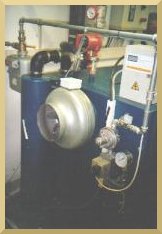
block heating generator,
backside
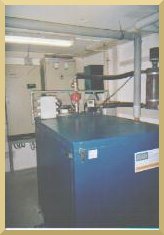
block heating generator,
frontside
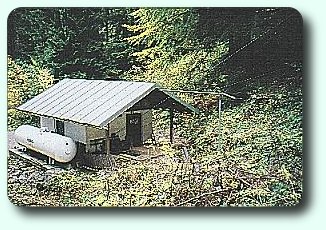
base station ropeway
gas tank and gase hose cognizable
- Primary energy/gas supply; Propan liquid gas (LPG), 6400 Liter
gastank at the base station (1100 m), Refill by regular tank car
via forrest road, hut supply via gas-pipe`` DN 20, NP 100, length
abt. 600 meter and height abt.250 m, fixing by steelrope on ropeway
supporter, prepressure steering 500 - 700 mbar, endpressure
steering at the hut for kitchen and BHKW
- Block-heating-generator (BHKW) from firm EAW in Westenfeld, 230
/ 400 V three phase current, Synchrongenerator, power abt. 7,5 kVA
electrical and 18 kW thermal, Ford 4 cylinder ottomotor with vacuum
operated control; for low noise fixed on dam-felt, noise 60 dBA,
operation with propangas (max. 50 min. 30 mB), warmth exchanger
with condensate trap/ -outflow, 24 V generator for starting battery
(automated starting) and regulation-tension, additional power
supply, potentialfree trouble report , Stamford three phase current
synchrongenerator, condensate pump, 70 mm plastic waste gas
pipe
- warmth store (abt. 500 kW) 2 layer store tank a 3800 Liter
store 100% of thermal energy of the electric current production for
alternating use during operation of the hut
- industrial batteries OPZS 48Volt DC, 1200 Ah load, for the
storing of redundant electric energy (for later use).
4.4 Mechanism of the Energy Supply System

Akku-Batterie 48 V
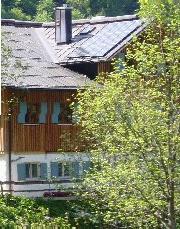
Photovoltaik on the roof
- The newly installed system has 3 bidirectional invers rectifier
at a 48V71200Ah battery block (accumulators). They are such
synchronized to build a 3-phases current net at the hut. 4.5 kWp
are permanently possible. Based on a certain level the block
heating generator or/and the diesel generator will be added to the
system.
- The inverse rectifier are such tuned that the block heating
generator will be operated with best efficiency. If more energy is
neccessary as the block heating generator can deliver, the inverse
rectifier will add energy from the battery block. Is the energy
demand less then the battery block will be loaded.
- All components can also be manually operated by the hut warden.
The components are switched and wired so that each can supply the
hut independantly from others.
- All components are industry standard, not special devices. A
photovoltaic device on the huts roof supports the block heating
generator. It is most valuable in wintertime. Its power is
sufficient to maintain the battery block without the necessity of
operating the block heating generator.
5. Capital Expenditure
Only for a part of the necessary activities frame-contracts
could be fixed. Individual contracts were made f.i. for brickwork
for the gas pipe ( base for the gas tank, ropefixing, a.s.o.),
shifting of the switchboards, increasing of the control
ingeneering, service works and some smaller additions. Especially
proplematic was to keep in order the parallel operation of the
supply engineering (ropeway, drinking water, electric power)
without break.
6. Block Diagram of the Energy Supply
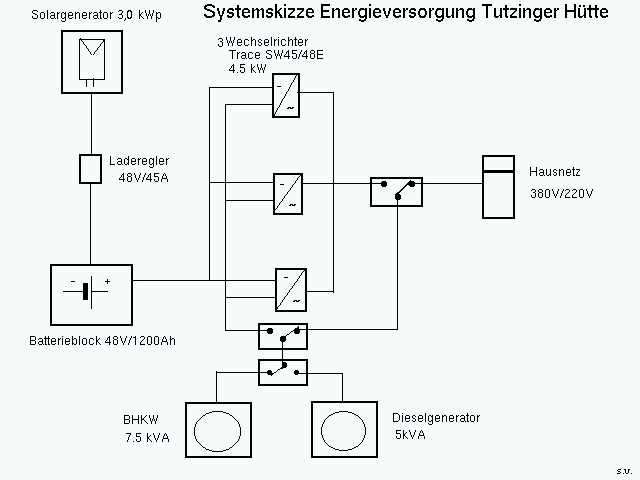
Draft: Ingenieurbüro Dipl.-Ing.
Phys. Michael Berger, Garmisch-Partenkirchen
Drawing: Ulf Schreglmann







